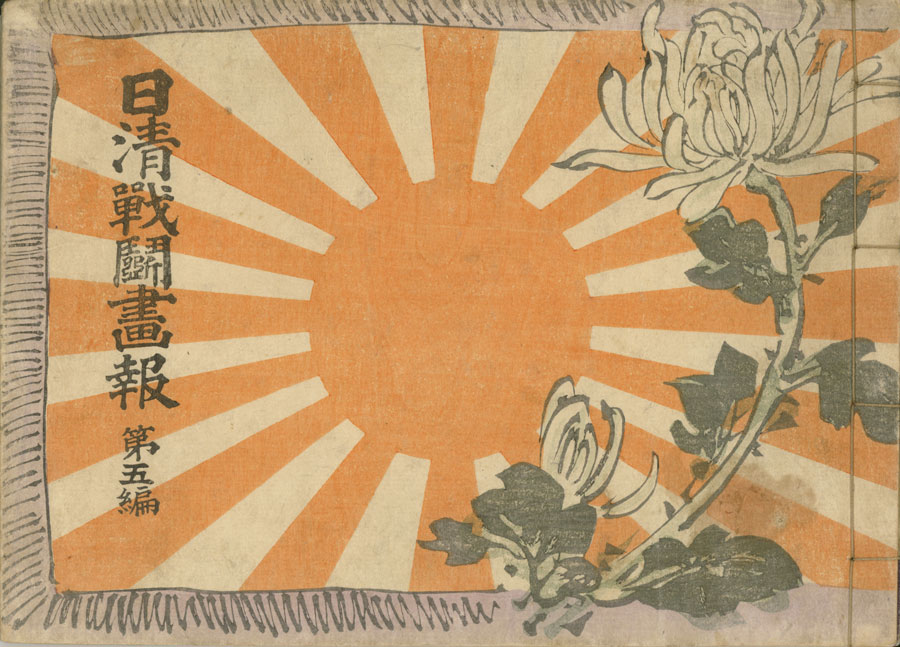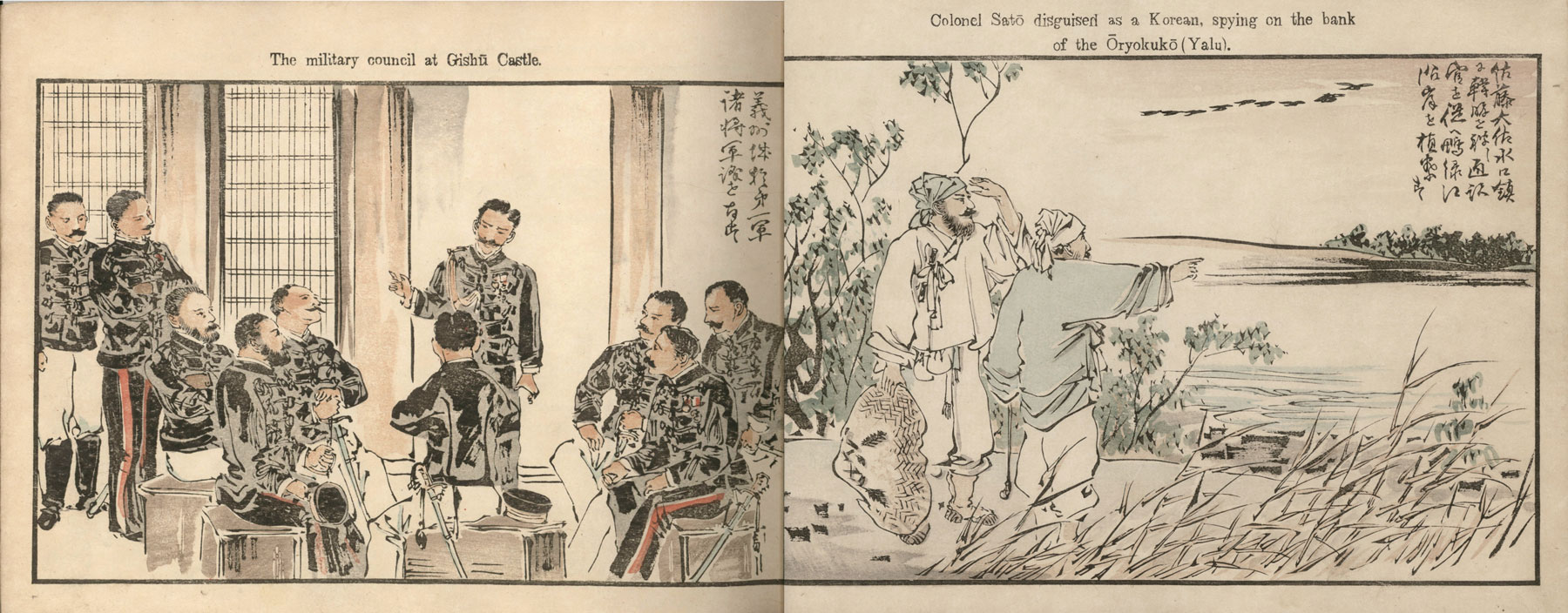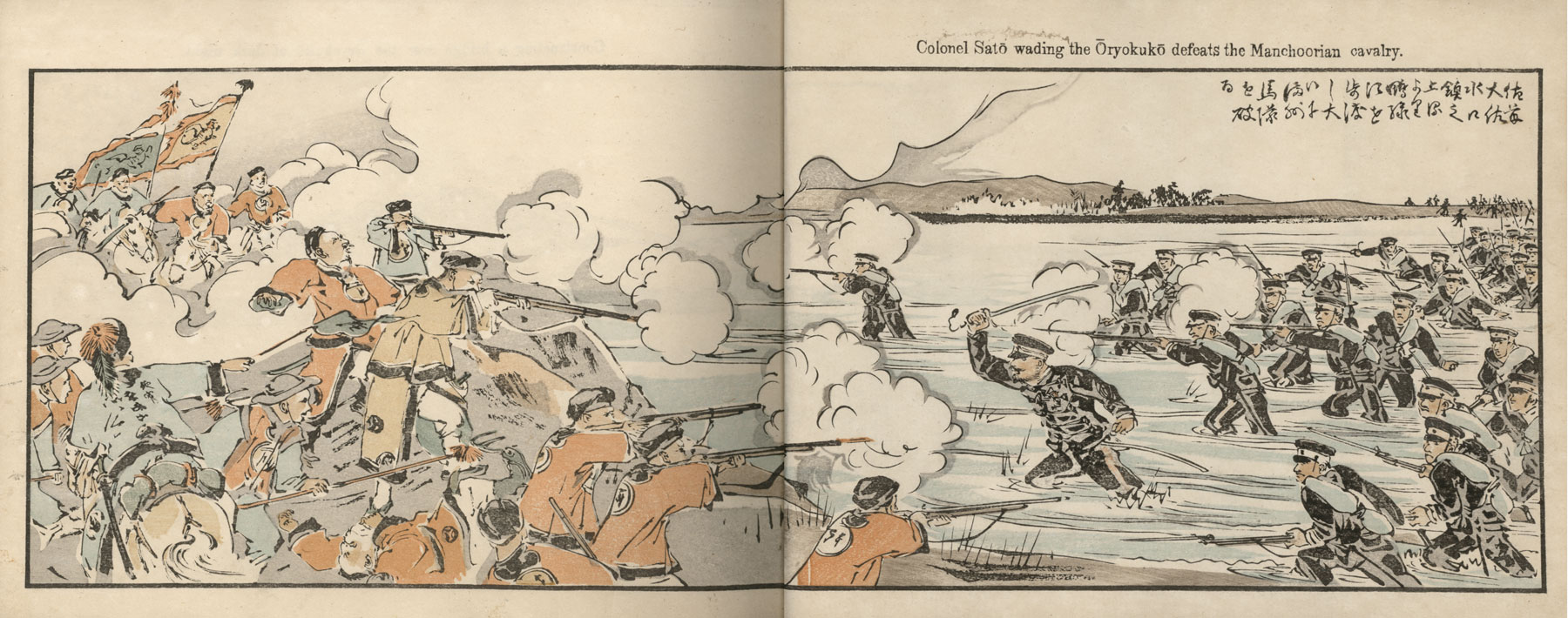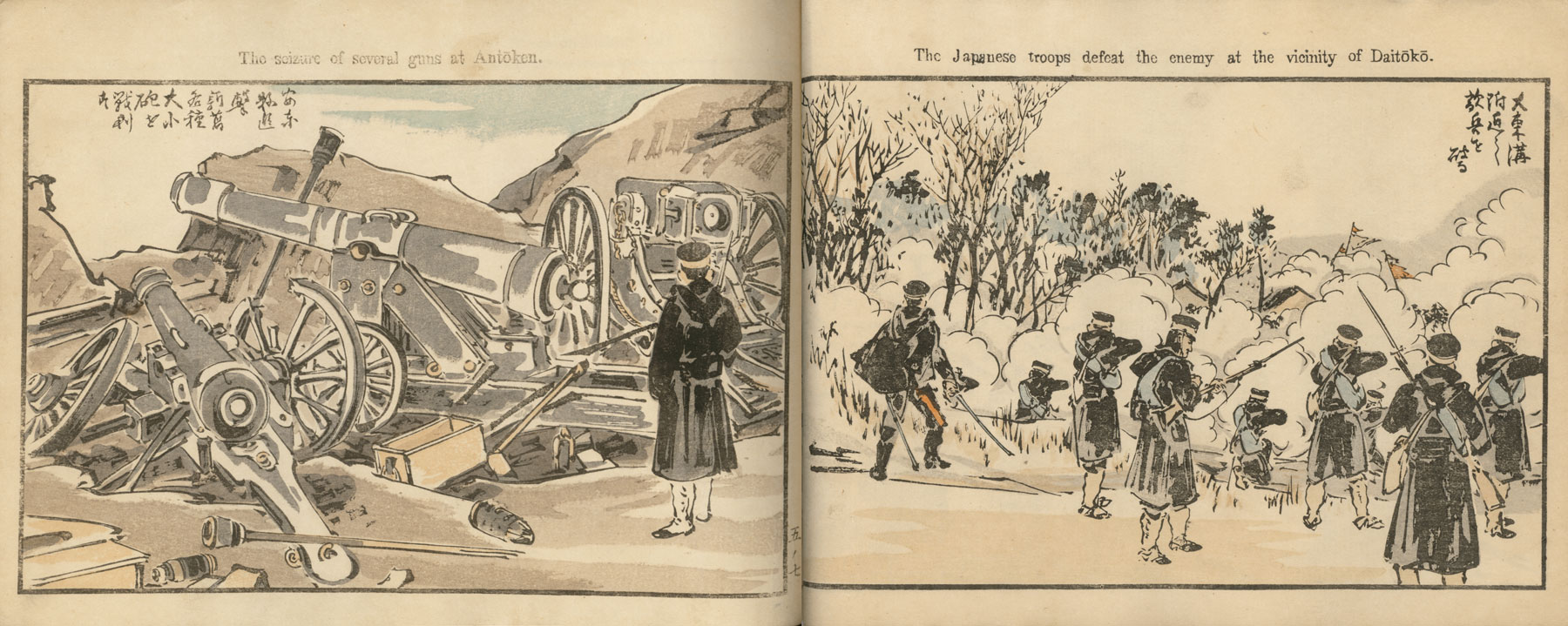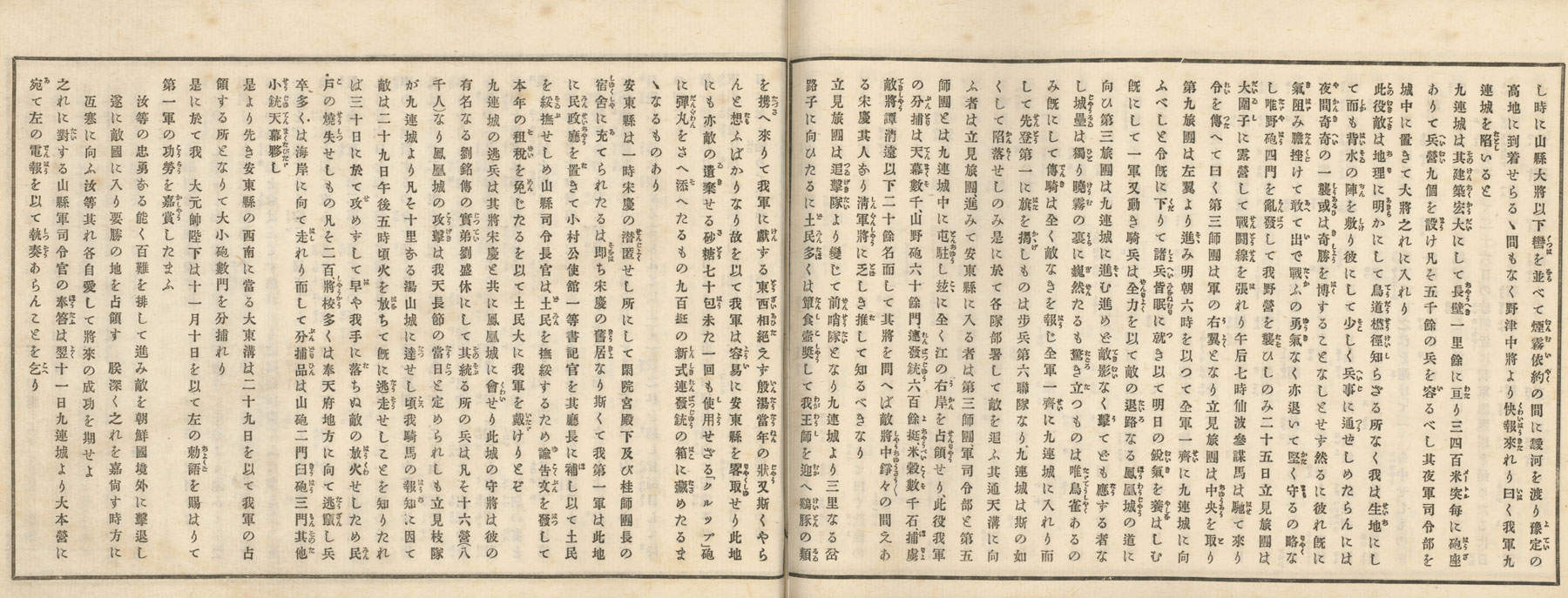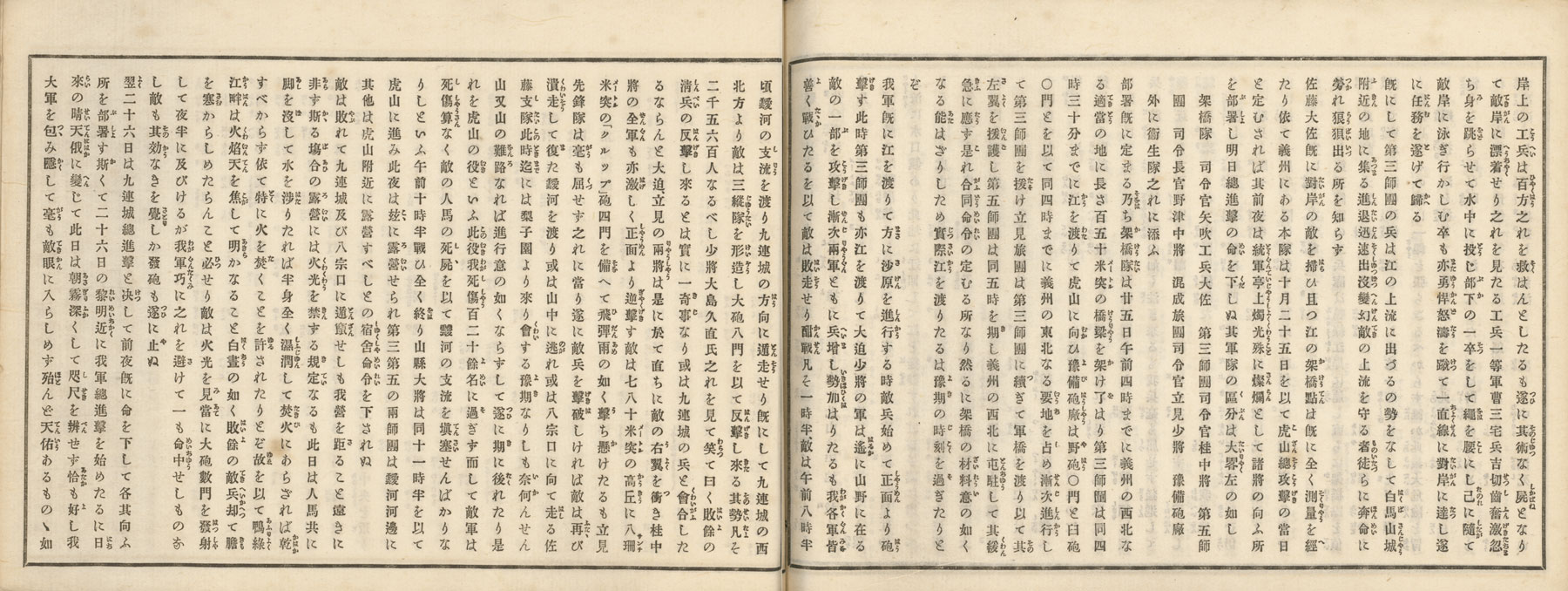About This Book
Volume 5 of a total of eleven bound volumes1 forming a pictorial account of the first Sino-Japanese War, from its outbreak in the summer of 1894 to Japan's sea-victories at Weihaiwei, Japan's advance into Manchuria and finally the peace treaty ending the war in April 1895. The eleven volumes were published at irregular intervals between October 21st 1894 and June 6th 1895. Each volume has an introduction written by a well-known figure of the time. The books were produced from carved woodblocks and are bound in the usual method of "bound-pocket books" (Fukuro toji 袋綴じ). Volumes 5 through 11 have English captions above the illustrations.The illustrations in these books were widely dispersed overseas to an audience closely following the war, as can be seen from the below illustrations from Volume 6 that appeared in the 1895 French publication Revue Encyclopédique: Recueil Documentaire Universel et Illustré, published by Georges Moreau in Paris.
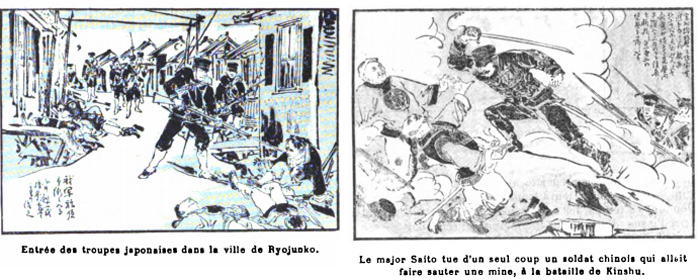

Images as they appear in Volume 6 of Illustrated Account of the Sino-Japanese War
Source: Japan at the Dawn of the Modern Age – Woodblock Prints from the Meiji Era, Louise E. Virgin, Donald Keene, et. al., MFA Publications, 2001, p. 68.
"A unique and important source of inspiration for the Sino-Japanese War print artists was the journalistic reports written and illustrated by the Kyoto painter Kubota Beisen (1852-1906). Accompanied by his two sons, Beisai and Kinsen, Beisen actually followed the troops [the First Army division] and recorded their battles in words and sketches. And Beisen himself was depicted almost as a war hero in a small number of triptych designs." (See the print Ban-Banzai for the Great Japanese Empire! Illustration of the Assault on Songhwan: A Great Victory for Our Troops.)
Source: A Much Recorded War: The Russo-Japanese War in History and Imagery, Fredrick A. Sharf, Anne Nishimura Morse, Sebastian Dobson, MFA Publications, 2005, p. 40-41.
"In their ten-volume2 Illustrated Record of the Battles of the Sino-Japanese War, from 1894-95, Beisen and his two sons describe the events of the war against a landscape this is beholden to East Asian literati painting and prints, with fibrous texture strokes used to define mountainsides and riverbanks and stippling to suggest the foliage on the trees. Yet the artists have consistently modeled the figures of the Japanese soldiers with light and darks to heighten the solidity of their forms. This modeling contrasts with the time-honored use of simple hooked outlines to define the figures of the Chinese combatants."
Source: A Much Recorded War: The Russo-Japanese War in History and Imagery, Fredrick A. Sharf, Anne Nishimura Morse, Sebastian Dobson, MFA Publications, 2005, p. 40-41.
"In their ten-volume2 Illustrated Record of the Battles of the Sino-Japanese War, from 1894-95, Beisen and his two sons describe the events of the war against a landscape this is beholden to East Asian literati painting and prints, with fibrous texture strokes used to define mountainsides and riverbanks and stippling to suggest the foliage on the trees. Yet the artists have consistently modeled the figures of the Japanese soldiers with light and darks to heighten the solidity of their forms. This modeling contrasts with the time-honored use of simple hooked outlines to define the figures of the Chinese combatants."
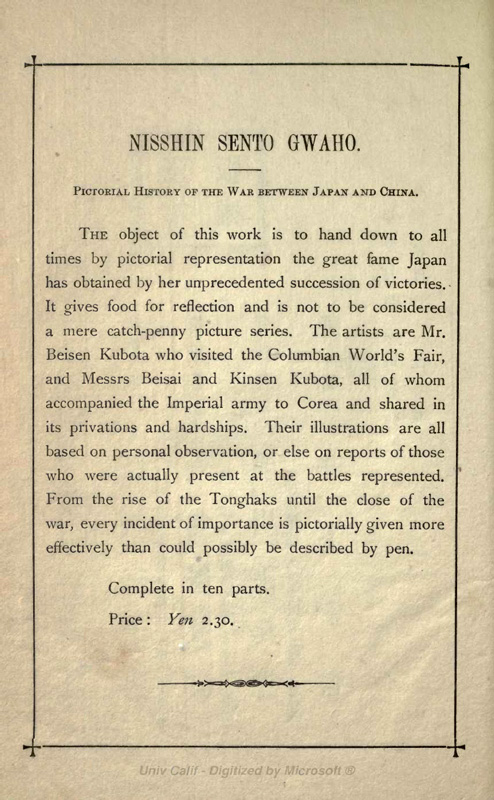
Ad appearing in A Concise History of the War Between Japan and China,
compiled by Jikichi Inouye, Osaka: Z. Mayekawa, Tokyo: Y. Okura, 1895.
compiled by Jikichi Inouye, Osaka: Z. Mayekawa, Tokyo: Y. Okura, 1895.
[note: while the ad states "Complete in ten parts." an eleventh volume was added at a later date.]
2015 Reprint of All Eleven Volumes
I n 2015, the Osaka publisher Sōgensha 創元社 reprinted all eleven volumes in a single 470 page volume with additional commentary.
n 2015, the Osaka publisher Sōgensha 創元社 reprinted all eleven volumes in a single 470 page volume with additional commentary.
Egakareta Nisshin Sensō: Kubota Beisen "Nisshin sentō gahō": eiin, honkokuban, gasha Kubota Beisen, Kubota Beisai, Kubota Kinsen ; Ōtani Tadashi, Fukui Junko hen.
描かれた日清戦争 : 久保田米僊「日清戦闘画報」 : 影印・翻刻版
I
Egakareta Nisshin Sensō: Kubota Beisen "Nisshin sentō gahō": eiin, honkokuban, gasha Kubota Beisen, Kubota Beisai, Kubota Kinsen ; Ōtani Tadashi, Fukui Junko hen.
描かれた日清戦争 : 久保田米僊「日清戦闘画報」 : 影印・翻刻版
1 Ten volumes were originally planned, but an eleventh titled 凱旋編 (Triumphal Return) was added at a later date.
2 See note 1 above.
.
Volume 5 covers events around the area of Fenghuancheng and contains a map of the area and an interpretation of events. The artist pictures himself speaking with a soldier in the illustration titled "General Ōseko shooting the enemy from the hill Kozan." No injured or dead Japanese troops can be seen in any of the illustrations.
See the print Picture of the Hard Fight at Fenghuangcheng by Ogata Gekkō (1859-1920) for a brief report by the journalist Beisen of the fighting at Fenghuangcheng.
Notes:
1. The below descriptions in Japanese are taken from the National Diet Library https://dl.ndl.go.jp/info:ndljp/pid/995306
2. All misspellings and grammatical errors in the captions have been carried forward. Where the names of Japanese military officers have been obviously translated into English incorrectly, I've corrected those names within brackets.
page 4-5 佐藤大佐水口鎮に於て韓服を着し通訳官を随へ鴨緑江沿岸を偵察す図 Colonel Satō disguised as a Korean, spying on the bank of the Ōryokukō (Yalu).義州城に於て第一軍諸将軍議を為す図 The military council at Gishū Castle. | page 2-3 | page 1 序 Preface |
| page 10-11 黒田少将裁州東方の高地より野砲臼砲を以て敵塁を射撃す図 The assault by Lft. General Katsura [Major General Kuroda] on the hill of Kozan. | page 8-9 義州城外暗夜鴨緑江に架橋す図 Constructing a bridge over the Ōryokukō at dark night. 大迫少将右翼隊虎山の東方高所に登つて敵兵を撃つ図 General Ōseko [Ōsako] shooting the enemy from the hill Kozan. | page 6-7 佐藤大佐水口鎮の上流より鴨緑江を歩渡し大に満州馬隊を破る図 Colonel Satō wading the Ōryokukō defeats the Manchoorian cavalry. |
page 16-17 安東県追撃新旧各種大小砲を戦利す図 The seizure of several guns at Antōken. | page 14-15 奥山少将左翼支隊九連城附近攻撃図 Maj. General Kuroda [Major General Okuyama] cannonading the enemy's entrench ments from Gishu. 山県大将九連城に入る図 General Yamagata enter to Kyūrenjō. - unread seal | page 12-13 立見少将湯山城附近攻撃図 Maj. General Tatsumi defeats the enemy on their returning attack. |
| page 22-23 第二軍花園口に上陸す図 Landing of the 2nd corps d'armée at Kwayenkō. | page 20-21 大同江に艦隊運送船〓輳す図 The assemblage of war-vessels & transports on mouth of the Daitōkō (Tai-tong-kang). | page 18-19 福島中佐大沽山に進軍す図 The march of Lt. Colonel Fukushima for Taikozan. |
| page 28-29 | page 26-27 歴史記事 Historical account | page 24-25 歴史記事 Historical account |
Historical account | page 30-31 Historical account | |
-intentionally left blank- | page 38-39 colophon 明治廿七年十二月廿九日印刷 明治廿七年十二月三十日發行 畵者 久保田米僊 畵者 久保田米齊 畵者 久保田金仙 編輯兼 発行人 大倉保五郎 印刷人 杉原辨次郎 発賣所 大倉書店 印刷所 杉原活版所 剞劂人 梅澤巳之吉 printed on December 29, 1894 published on December 30, 1894 painter Kubota Beisen painter Kubota Beisai painter Kubota Kinsen editor and publisher Ōkura Yasugorō printer Sugihara Benjirō publishing house Ōkura shoten printing office Sugihara kappanjo carver Umezawa Minokichi 初編目次 第貮編目次 第三編目次 第四編目次 Table of contents for the first four volumes | page 36-37 歴史記事 Historical account 鳳凰城所近之图 rough battle map of Fenghuangcheng |
Book Details
| IHL Catalog | #548 |
| Title/Description | Illustrated Account of the Sino-Japanese War, Volume 5 日清戦闘畫報* 第五編 (Nisshin Sentō Gahō, daigo hen) *typically seen written as 日清戦闘画報 [also written as 日清戰鬪畫報 and 日清戰鬥畫報] |
| Artist |  Kubota Beisen (1852-1906) [assisted by his sons Kubota Beisai 久保田 米齊 (1874-1937) and Kubota Kinsen 久保田 金仙 (1875-1954)] Kubota Beisen (1852-1906) [assisted by his sons Kubota Beisai 久保田 米齊 (1874-1937) and Kubota Kinsen 久保田 金仙 (1875-1954)]left: detail from colophon 畫者 [illustrators]: 久保田 米 僊 久保田 米 齊 久保田 金 仙 |
| Signature | illustrationsnot signed unless noted on above thumbnails |
| Seal | illustrationsnot sealed unless noted on above thumbnails |
| Publication Date | December 30, 1894 明治廿七年十二月三十日發行 |
| Edition | |
| Publisher | Ōkura Yasugorō 大倉保五郎 (Ōkura shoten)- Tokyo |
| Carver | Umezawa Minokichi 梅澤巳之吉 |
| Printer | Sugihara Benjirō 杉原辨次郎 |
| Impression | excellent |
| Colors | excellent |
| Condition | good - minor toning and staining throughout; binding and all pages in tact with little edge or paper wear |
| Miscellaneous | |
| Genre | ehon 絵本; senso-e |
| Format | fukurotoji |
| H x W Paper | 6 3/4 x 9 1/4 in. (17.1 x 23.5 cm) |
| Collections This Book | Museum of Fine Arts, Boston 2000.338 (Volume 3); Victoria & Albert Museum E.2531-1925 (volumes 1-5 and 8); Rijksmuseum Netherlands RP-P-2005-594; Japanese Special Collection in Sterling Memorial Library at Yale University, ID #1121 (Volume 3); UCLA Libraries and Collections Record ID 2035932 (Volumes 1-3); University of Chicago Library Call No.: J6289.2 2269 (Volumes 1-3); Cornell University Library call number Asai Rare DS765.K95 (Volumes 1-11); Williamsburg Research Libraries Partnership Swem Library DS765 .K82 v.1 (Volumes 1-11); Columbia University Libraries East Asian SPECIAL COLL. DS765.K82 1894 (Volumes 1-11); Brown University Library Hay Military DS765.K83x 1894 (Volumes 1-8); Harvard University HOLLIS: 007566215 (Volumes 1-11); St. Louis Museum of Art 854.2010, 855.2010, 848.2010 (Volumes 4, 5, 8) |
| Reference Literature | Japan at the Dawn of the Modern Age – Woodblock Prints from the Meiji Era, Louise E. Virgin, Donald Keene, et. al., MFA Publications, 2001, ill. 23, p. 63; In Battle's Light: Woodblock Prints of Japan's Early Modern Wars, Elizabeth de Sabato Swinton, Worcester Art Museum, 1991, p. 14; The World of the Meiji Print: Impressions of a New Civilization, Julia Meech-Pekarik, Weatherhill, 1986 p. 206; Conflicts of Interest: Art and War in Modern Japan, Philip K. Hu, et. al., Saint Louis Museum of Art, 2016, p. 158-160. |
5/14/2020
12/8/2018


